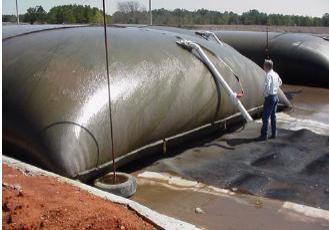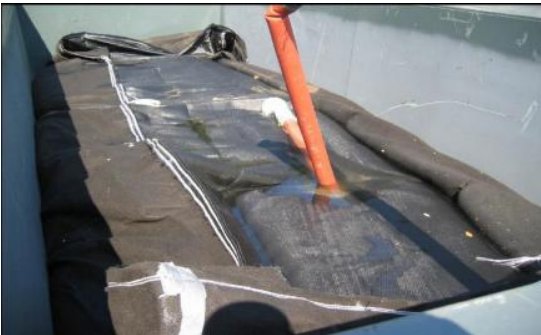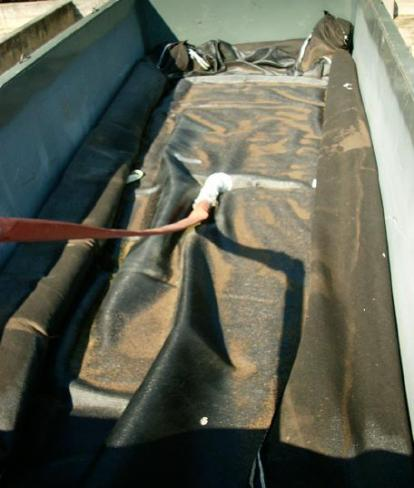Geotextile tubes are large sludge dewatering bags or geo-containers constructed from high strength, permeable geotextiles. They work with any material that is hydraulically transported. In most applications, the e of polymers is recommended to enhance the dewatering process. Geotextile tubes are cost-effective, fast, and efficient and have minimal environmental impact.
The list of materials that can been dewatered by geotextile tubes includes:
o Municipal water treatment and wastewater sludge
o Contaminated dredged material
o Marine dredgings
o Agricultural animal waste
o Fine-grained, inorganic industrial sludge
o Construction dewatering
o Shale fracking waste water

As an alternative to sludge lagoons, wet hauling, sand drying beds, wedge wire systems, presses and other mechanical dewatering methods, geotextile tubes offer significant cost savings. And they are environmentally friendly. Often, the decanted water can be reed or discharged into local water tables, streams or storm drainage systems. Because they dewater faster than open-air pits and do not require standard heavy equipment, they create a smaller foot-print, increasing the number of potential dewatering sites and optimizing land age when the area for containment and dewatering is limited. Sludge dewatering tubes are made from tough, UV resistant geotextiles.
o Cost-effective alternate to traditional methods
o Minimal environmental impact
o Small footprint
o Optimize land age
o Dewater faster
o Work with a large variety of sediments, sludge and sand
o High-strength, permeable geotextile
o Tough, UV resistant
HUATAO Tube are manufactured from high strength polypropylene geotextiles and are permeable and resistant to ultra-violet light and the stresses associated with filling and placement including: abrasion, tearing, puncturing and flattening.
Tube geotextile tubes are made to the desired diameter from standard width geotextiles. The length of the sludge dewatering tube is limited only by its weight. Filling ports are regularly spaced along the length of the tube at appropriate intervals.
In most cases, the HUATAO Tube will be delivered to the site on a skid, rolled up on a pipe core. Alternate packaging, such as accordion folding, may be ed. Although sturdy, geotextile tubes can be damaged during loading, off-loading and shipping. It is very important that any shipment be thoroughly inspected for rips and punctures before signing any shipping documents. In the case of damage, all problems should be noted on the shipping documents and the delivery refed. Once a damaged tube has been received and the shipping documents signed, it is nearly impossible to seek remedy from the shipping company.
o Inspect geotextile tube for shipping damage
o Unroll tube flat on level ground
o Make sure tube is constrained and secured
o Place tube on an impermeable geomembrane if erosion is a concern
o Connect and secure pump hose to filling port sleeve
o Monitor geotextile tube during filling for possible ruptures
o Utilized repeated cycles of filling and dewatering
o Deposit filled tube properly in a landfill or cut open and remove solids
Every geotextile tube project is unique. As such, only general guidelines can be described, but each project requires consultation with a geotextile tube expert to identify the project’s singular attributes and to design the sludge dewatering process accordingly.
site preparation is of most importance. Geotextile tubes can roll, especially during filling. It is important that they are constrained and placed on level ground. Once properly deployed and secured in place, the geotextile tube is hydraulically filled with dredged materials using a cutter head and suction dredge or with sludge materials using a feed pump.
HUATAO Tub have a “shirt-sleeve” style filling port. Simply place the hose into the port and secure it with a hose clamp, tie-wire or duct tape.

Begin pumping
Once the pumping begins, clear, effluent water will drain from the geotextile tube through the small openings in the permeable geotextile fabric. Often the decanted water can be reed or returned to waterways without additional treatment. During pumping, the elevation or height of the tube needs to be monitored to prevent ruptures.
A large volume of water may be released from the tubes during the operation and can cause erosion around the tube. As such, the rate at which the water is decanted mt be monitored. The sludge dewatering tube bottom will develop a filter cake quickly, so the water will decant mainly out of the sides and top of the tube. Therefore, it may be beneficial to cover the deployment area in plastic such as Visqueen and deploy sump pumps at all four corners of the dewatering area to collect the effluent. The effluent
can then be returned creating a “closed-loop” system. If the tube will be exposed to external moving water, a scour apron made from animpermeable geomembrane
linerwith an attached anchor tube may be required.
Since the dewatering process will happen more slowly than the rate of hydraulically transported sludge entering the HUATAO Tube, repeated cycles of filling and dewatering will be required. After the final cycle, the solids in the geotextile tube will continue to densify further as residual water vapor escapes through the geotextile fabric. Typically over 99% of solids are captured.
Geotextile tubes fill to a complex, elliptical shape. As such, the tube will not fill to its theoretical volume. Typically 50%-60% is a realistic expectation.
When full, the entire sludge dewatering tube and its contents can be deposited in a landfill, remain on site, or the bag can be opened and the solids removed. To remove the solids, cut open the top of the HUATAO Tube with a box-cutter and fold back the geotextile. use a front end loader or excavator to scoop the material and load it into a dump truck or apply it directly to land if appropriate. The used HUATAO Tube can be
hauled off to a solid waste facility.

Dewatered Geotube ready for filling process to be repeated.
The nature of the material and federal, state and local regulations will help determine the acceptable procedure. Always get approval from the local regulatory agency before disposing of the sludge and the sludge dewatering tube.
For large volume projects or on sites with a limited dewatering area, geotextile tubes can be stacked in layers. Stacking tubes requires addressing the unique issues
affiliated with the project and project site. Proper site preparation and safety issues mt be followed in addition to other considerations.
Often a polymer coagulant or flocculant is required to improve the dewatering process. Polymers help the solids bind together. The proper polymer improves the rate of dewatering, increases the rate and percentage of spension of solids and improves the clarity of the effluent. Selecting the right polymer is critical. If some fines or color is acceptable in the filtrate, then a polymer may not be required.
ers that mt be considered include: sludge flow, sludge concentration, flocculent flow, flocculent concentration, post-dilution water flow and injection points. It’s always best to consult with a professional polymer supplier and conduct bench tests to determine the correct products, optimum dosage and proper methods for setting up a polymer mixing and injection system. HUATAO offers small, hanging bags to test your sludge before purchasing an HUATAO Tube for your project.
can not be empty
can not be empty
